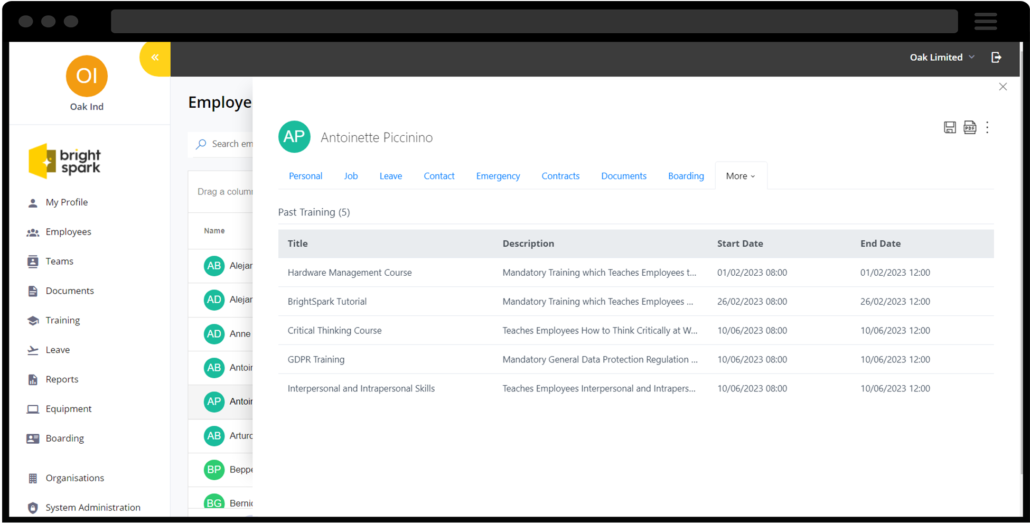About Brightspark
We believe that teamwork is the key to success. Perfecting the art of teamwork, however, is no small feat. Ensure that your employees are motivated, ready and available for the next big project with Brightspark!
Employees are constantly on the lookout for opportunities to grow, both in their professional and personal lives. In fact, career growth ranks among the top three non-financial motivators, with approximately 75% of employees actively seeking ways to advance their careers.
This trend shows no signs of slowing down, particularly among the Millennial generation, who place a higher priority on support, coaching, and career advancement pathways. However, fostering employee growth is a challenge for many organizations. They grapple with the dilemma of encouraging development while maintaining productivity and profitability.
As a result, employee development often takes a back seat in the midst of hectic workplaces. To improve employee turnover rates and satisfaction, here are some effective strategies to create a growth-oriented workplace:
#1 Coaching and Mentoring
Coaching and mentoring are essential for guiding employee development, offering two different yet complementary approaches. Mentoring provides long-term guidance from experienced professionals, fostering trust and deep relationships. It supports new employees by giving them a clearer understanding of company culture, while also accelerating their learning curve. Formal programs, like structured mentorship, ensure every employee gets the attention they need. Informal mentoring creates natural relationships that promote ongoing learning.
Coaching, meanwhile, offers more targeted and goal-oriented support. Unlike mentoring, which focuses on broad professional development, coaching hones specific skills or behaviors. Coaches provide direct feedback, set personalized goals, and help employees overcome immediate challenges. In high-performing organizations, regular coaching sessions increase performance by 27%, according to Gallup. Our experts believe that making coaching a regular part of managerial duties promotes a more engaged and skilled workforce.

Additionally, the benefits of both coaching and mentoring are amplified when senior leaders are involved. Reverse mentoring, where younger employees coach senior staff on new technologies or trends, adds value at all levels of an organization. It strengthens relationships across generations and promotes a bi-directional learning culture.
#2 Constructive Feedback
Constructive feedback is a tool that fuels continuous improvement. Employees, especially Millennials and Gen Z, expect consistent feedback, not just annual reviews. When feedback is delivered effectively, it creates a culture of open communication and accountability. Positive feedback reinforces strengths and accomplishments, motivating employees to continue performing at a high level. Constructive, or negative, feedback focuses on areas for improvement and offers actionable steps to address weaknesses. Together, they create a balanced approach to growth.
Organizations that build feedback loops into their daily processes see improved employee performance and engagement. Deloitte research reveals that ongoing feedback improves employee performance by as much as 21%. Our experts suggest that managers engage in “feedforward” discussions, which focus on future potential rather than past mistakes. This not only reduces defensiveness but also fosters a growth mindset, helping employees become more resilient and adaptable.
Further, peer-to-peer feedback is often underutilized but highly effective. Encouraging colleagues to give each other feedback can build trust within teams and provide a fresh perspective on strengths and opportunities. Leaders can foster a feedback culture by creating environments where feedback is welcomed and used for improvement, rather than being perceived as criticism.
of employees are seeking opportunities for career growth (CorbettInc)
of employees quit due to a lack of development opportunities. (Gallup.com)
of employees appreciate both negative and positive feedback. (officevibe.com)
#3 Professional Training
Training is a traditional yet evolving approach to employee development. Today, professional training extends far beyond attending seminars or completing certifications. It includes personalized learning paths, online modules, microlearning, and gamified experiences. With employees expecting flexibility in their learning journeys, the one-size-fits-all approach is outdated. Mercer’s 2023 Global Talent Trends Report shows that companies that offer customized training see higher engagement, as employees feel their specific development needs are being met.

In today’s fast-paced work environment, employees need both technical and soft skills to succeed. Programs that offer a combination of job-specific training and leadership development are more effective in fostering a well-rounded workforce. Additionally, e-learning platforms such as LinkedIn Learning or Coursera allow employees to learn at their own pace, creating an accessible and convenient way to keep their skills sharp.
Our experts recommend companies focus on integrating technology into their learning programs. AI-powered platforms can provide individualized course recommendations based on the employee’s role and career goals, ensuring more relevant and timely training. Such tools not only make learning more engaging but also help employees develop critical skills that align with the organization’s strategic priorities.
Finally, incentivizing training with certifications or professional development credits encourages employees to take ownership of their learning journeys. This creates a sense of accomplishment and adds tangible value to their resumes.
#4 Lead by Example
Leadership sets the tone for any organization’s culture, and this is particularly true when it comes to growth and development. Employees often mirror the behaviors of their leaders. When senior management prioritizes their own learning, it fosters an environment where development is valued. Leaders who actively participate in workshops, pursue certifications, and openly discuss their learning journeys signal to employees that growth is an ongoing process, not a one-time event.
PwC’s 2022 survey highlights that organizations where leaders prioritize personal development see higher levels of engagement and lower turnover rates. This stems from the fact that employees feel more empowered to pursue learning when they see it modeled by leadership.

Moreover, leaders should also create learning opportunities for their teams. Our experts believe in the power of leadership by example, where senior staff provide guidance, sponsor development programs, and facilitate knowledge-sharing events. When employees see leaders dedicating time to their development, they are more likely to invest in their own growth.
Additionally, the role of leadership in creating psychological safety cannot be overstated. When leaders are transparent about their own failures and learning curves, they foster an environment where employees feel safe to take risks, innovate, and grow.
#5 Cultivating a Growth Mindset
Cultivating a growth mindset, popularized by Carol Dweck, is about encouraging employees to view challenges as opportunities for growth, rather than threats. This philosophy builds resilience and adaptability, which are crucial in today’s ever-evolving work environment. According to Gallup’s 2023 research, employees with a growth mindset are 47% more likely to feel empowered in their roles. They are more open to learning, take on new responsibilities, and are not discouraged by setbacks.
Organizations that actively promote a growth mindset foster innovation, as employees are more willing to experiment and take calculated risks. Our experts recommend that managers recognize and reward effort and learning, not just outcomes. This encourages employees to embrace the learning process and strive for continuous improvement.
Implementing initiatives such as “failure-sharing” sessions, where teams openly discuss what went wrong and how to improve, normalizes failure as part of the learning process. This approach helps reduce the fear of mistakes and promotes a mindset focused on growth and solutions, rather than blame.
#6 Focus on Soft Skills Development
As roles become more complex, the demand for soft skills like communication, adaptability, and leadership is increasing. In fact, 91% of employers prioritize these skills in their hiring and development processes (World Economic Forum, 2023). Soft skills enable employees to navigate the interpersonal dynamics of the workplace, making them essential for team collaboration, customer relations, and leadership positions.
Our experts suggest integrating soft skills training into everyday activities, such as through role-playing exercises, group discussions, and team-based projects. This hands-on approach allows employees to practice and refine these skills in a real-world context.
Moreover, emotional intelligence (EQ) has become a critical skill for leaders. Managers with high EQ are better at managing teams, resolving conflicts, and driving engagement. Investing in emotional intelligence training programs can lead to more effective communication, better teamwork, and improved overall company culture.
Organizations that prioritize both technical and soft skills development create a more agile workforce, capable of navigating complex and fast-changing work environments.
A Winning Solution
In today’s ever-evolving workplace, fostering employee growth is crucial. Alongside strategies like coaching, feedback, and professional training, Brightspark offers an integrated solution. Our Manage features provide a streamlined approach to facilitate employee growth. Whether it’s training planning, certification management, appointment notifications, yearly training plans, or advanced training details, Brightspark is your ally in empowering employee development, making growth a natural part of your organization’s culture.

To get started with your Brightspark journey, get in touch today!
About Brightspark
We believe that teamwork is the key to success. Perfecting the art of teamwork, however, is no small feat. Ensure that your employees are motivated, ready and available for the next big project with Brightspark!
 Key Recruitment Challenges – And How To Overcome Them
Key Recruitment Challenges – And How To Overcome ThemInterested in becoming a Brightspark partner? Send us your contact details and we will be in touch!
Curious about how Brightspark fits into your organization? Our experts are more than happy to provide the guidance you need. Fill in the form below and we’ll be in touch shortly!
